Overview of Water Shutoff Operations in Oil and Gas Wells; Chemical and Mechanical Solutions
Abstract
:1. Introduction
2. Types of Water Production
3. Sources of Unwanted Water Production
4. Identifying the Problem
5. Chemical Solutions
5.1. Gel
5.2. Polymer Flooding
6. Mechanical Solutions
6.1. Plugs and Packers
6.2. Tubing Patches
7. Conclusion
Author Contributions
Funding
Conflicts of Interest
References
- Joseph, A.; Ajienka, J.A. A Review of Water Shutoff Treatment Strategies in Oil Fields. Presented at the Annual SPE International Conference and Exhibition, Tinapa-Calaber, Nigeria, 31 July–7 August 2010. [Google Scholar]
- Ahmad, N.; Al-Shabibi, H.; Malik, S. Comprehensive Diagnostic and Water Shut-off in Open and Cased Hole Carbonate Horizontal Wells. Presented at the Abu Dhabi International Petroleum Exhibition and conference, Abu Dhabi, UAE, 11–12 November 2012. [Google Scholar]
- Thomas, F.B.; Bennion, D.B.; Anderson, G.E.; Meldrum, B.T.; Heaven, W.J. Water Shut-off Treatments-Reduce Water and Accelerate Oil Production. J. Can. Pet. Technol. 2000, 39, 25–29. [Google Scholar] [CrossRef]
- Permana, D.; Ferdian, G.; Aji, M.; Siswati, E. Extracting Lessons Learned of 35 Water Shut-off Jobs in Mature Fields to Improve Success Ration of Water Shut-off Job. Presented at the SPE/IATMI Asia Pacific Oil & Gas Conference and Exhibition, Bali, Indonesia, 20–22 October 2015. [Google Scholar]
- McIntyre, F.J.; Grenon, J.P.; See, D.L. Horizontal Well Gas/Water Shutoff-Field Results. J. Can. Pet. Technol. 1999, 38, 23–27. [Google Scholar] [CrossRef]
- Sydansk, D.; Romero-Zeron, L. Reservoir Conformance Improvement, 1st ed.; Society of Petroleum Engineers: Richardson, TX, USA, 2011. [Google Scholar]
- Seright, R.S.; Lane, R.H.; Sydansk, R.D. A Strategy for Attacking Excess Water Production. SPE-84966-PA. SPE Prod. Facil. 2003, 18, 158–169. [Google Scholar] [CrossRef]
- Economides, M.J.; Hill, A.D.; Ehlig-Economides, C. Petroleum Production Systems, 18th ed.; Prentice Hall PTR: Upper Saddle River, NJ, USA, 2008. [Google Scholar]
- Guo, B.; Lyons, W.C.; Ghalambor, A. Petroleum Production Engineering a Computer-Assisted Approach; Gulf Professional Publishing: Houston, TX, USA, 2007. [Google Scholar]
- Fakher, S.; Elgahawy, Y.; Abdelaal, H.; Tonbary, A.; Imqam, A. Reducing Excessive Water Production Associated with Gas Hydrate Reservoirs Using a Thermal In-Situ Heating-Inhibitor Method. Presented at the SPE Kingdom of Saudi Arabia Annual Technical Symposium and Exhibition, Dammam, Saudi Arabia, 23–26 April 2018. [Google Scholar]
- Burov, A.; Kharrat, W.; Hussein, N.A. Innovative Coiled Tubing Water Shutoff Techniques in Horizontal Wells. Presented at the SPE International Symposium and Exhibition on Formation Damage Control, Lafayette, LA, USA, 15–17 February 2012. [Google Scholar]
- Yortsos, Y.C.; Choi, Y.; Yang, Z.; Shah, P.C. Analysis and Interpretation of Water/Oil Ratio in Waterfloods. SPE J. 1999, 4, 413–424. [Google Scholar] [CrossRef]
- Fayzullin, M.; Tippel, P.; Gonzalez, J.; Egger, S. Understanding Excessive Water Production in Highly Faulted Mature Gas Condensate Field: From Well Operations to Revival of Integrated History Matching. Presented at the IADC/SPE Asia Pacific Drilling Technology Conference, Bangkok, Thailand, 25–27 August 2014. [Google Scholar]
- Olarte, J.D.; Haldar, S.; Said, R.; Ahmed, M.; Burov, A.; Stuker, J.; Kharrat, W.; Wortman, H. New Approach of Water Shut off Techniques in Open Holes and World First Applications of Using Fiber Optic Services With Tension-Compression Sub. Presented at SPE/DGS Saudi Arabia Section Technical Symposium and Exhibition, Al-Khobar, Saudi Arabia, 15–18 May 2011. [Google Scholar]
- Al-Zain, A.; Duarte, J.; Haldar, S. Successful Utilization of Fiber Optic Telemetry Enabled Coiled Tubing for Water Shut-off on a Horizontal Oil Well in Ghawar Field. Presented at the SPE Saudi Arabia Section Technical Symposium, Al-Khobar, Saudi Arabia, 9–11 May 2009. [Google Scholar]
- Al Hasani, M.A.; Al Khayari, S.R.; Al Maamari, R. Diagnosis of Excessive Water Production in Horizontal Wells Using WOR Plots. IPTC-11958-MS. Presented at the International Petroleum Technology Conference, Kuala Lumpur, Malaysia, 3–5 December 2008. [Google Scholar]
- Zeinijahromi, A.; Bedrikovetski, P. Controlling Excessive Water Production Using Induced Formation Damage. Presented at the SPE European Formation Damage Conference and Exhibition, Budapest, Hungary, 3–5 June 2015. [Google Scholar]
- Surguchev, L.M. Water Shut-Off: Simulation and Laboratory Evaluation. Presented at the European Petroleum Conference, The Hague, The Netherlands, 20–22 October 1998. [Google Scholar]
- Sun, Y.; Fang, Y.; Chen, A. Gelation Behavior Study of a Resorcinol-Hexamethyleneteramine Crosslinked Polymer Gel for Water Shut-Off Treatment in Low Temperature and High Salinity Reservoirs. Energies 2017, 10, 913. [Google Scholar] [CrossRef]
- Al-Dhafeeri, A.M.; Nasr-El-Din, H.A.; Al-Harith, A.M. Evaluation of Rigless Water Shutoff Treatments to Be Used in Arab-C Carbonate Reservoir in Saudi Arabia. Presented at the CIPC/SPE Gas Technology Symposium 2008 Joint Conference, Calgary, AB, Canada, 16–19 June 2008. [Google Scholar]
- Gharbi, R.; Alajmi, A.; Algharaib, M. The Potential of a Surfactant/Polymer Flood in a Middle Eastern Reservoir. Energies 2012, 5, 58–70. [Google Scholar] [CrossRef] [Green Version]
- El-karsani, K.S.M.; Al-Muntasheri, G.A.; Hussein, I.A. Polymer Systems for Water Shutoff and Profile Modification: A Review Over the Last Decade. SPE J. 2014, 19, 135–149. [Google Scholar] [CrossRef]
- Bybee, K. Solving Excessive Water Production in a Long Horizontal Open Hole. J. Pet. Technol. 2009, 61, 63–65. [Google Scholar] [CrossRef]
- Denney, D. Factors Affecting Mechanical Water Shutoff. J. Pet. Technol. 2001, 53, 58–59. [Google Scholar] [CrossRef]
- Offenbacher, M.; Gadiyar, B.; Messler, D. Swellable Packer Fluids Designed for Zonal Isolation in Openhole Completions. Presented at the SPE European Formation Damage Conference and Exhibition, Budapest, Hungary, 3–5 June 2015. [Google Scholar]
- Wilson, P.; Hoffman, C.E. Zonal Isolation in Stimulation Treatments and Gas/Water Shutoff Using Thermally Compensated Inflatable Packers and Plugs. Presented at IADC/SPE Asia Pacific Drilling Technology, Kuala Lumpur, Malaysia, 11–13 September 2000. [Google Scholar]
- Plante, M.E.; Mackenzie, G.R.J. Selective Chemical Water Shutoffs Utilizing Through-Tubing Inflatable Packer Technology. Presented at SPE/ICoTA Coiled Tubing Roundtable, Houston, TX, USA, 5–6 April 2000. [Google Scholar]
- Lizak, K.F.; Zeltmann, T.A.; Crook, R.J. Permian Basin Operators Seal Casing Leaks with Small-Particle Cement. Presented at SPE Permian Basin Oil and Gas Recovery Conference, Midland, TX, USA, 18–20 March 1992. [Google Scholar]
- Meek, J.W.; Harris, K. Repairing Casing Leaks Using Small-Particle-Size Cement. SPE Prod. Facil. 1993, 8, 45–50. [Google Scholar] [CrossRef]
- Bybee, K. Unique Rigless Casing Leak Repair. J. Pet. Technol. 2001, 53, 28–29. [Google Scholar] [CrossRef]
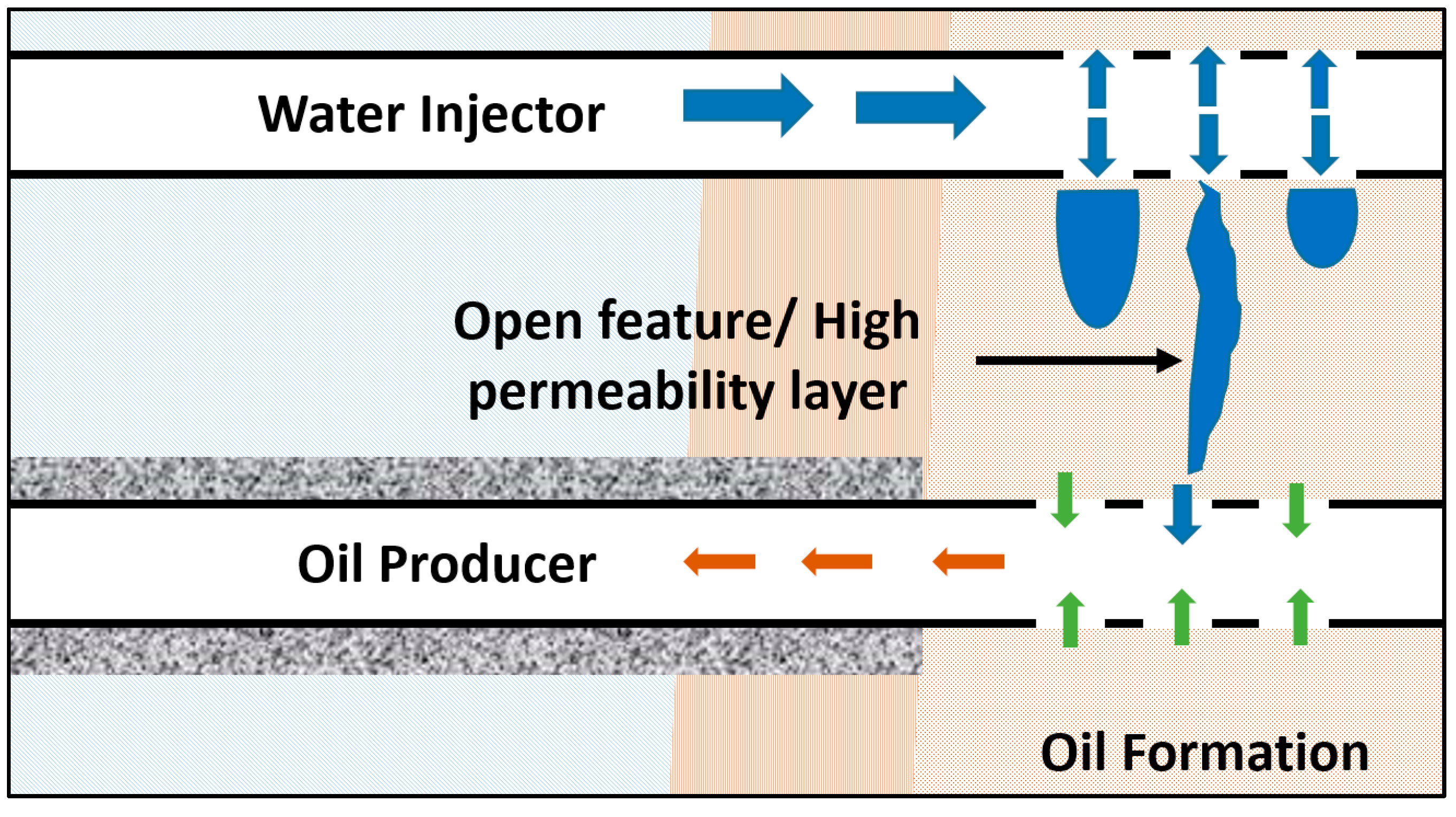
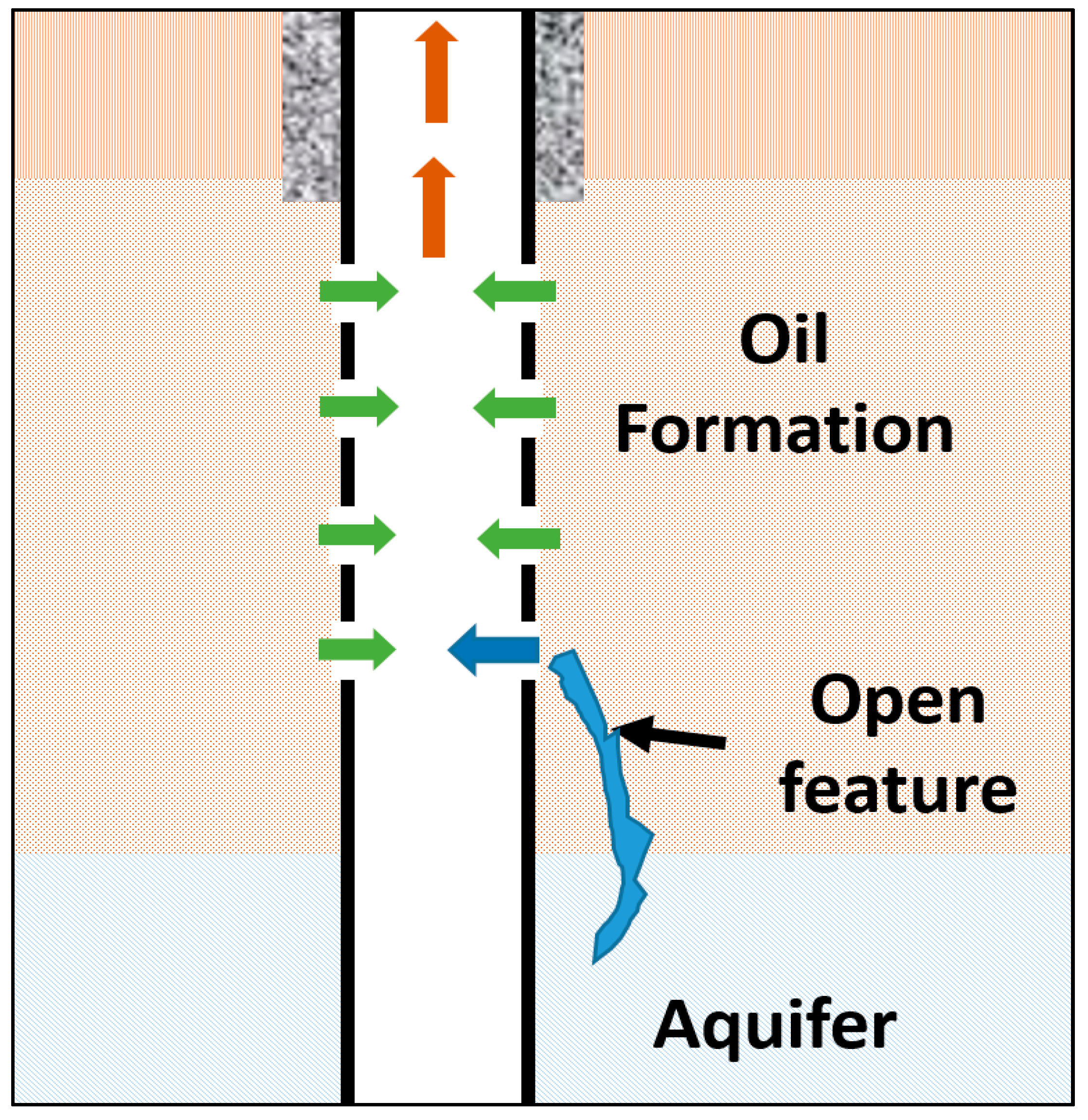
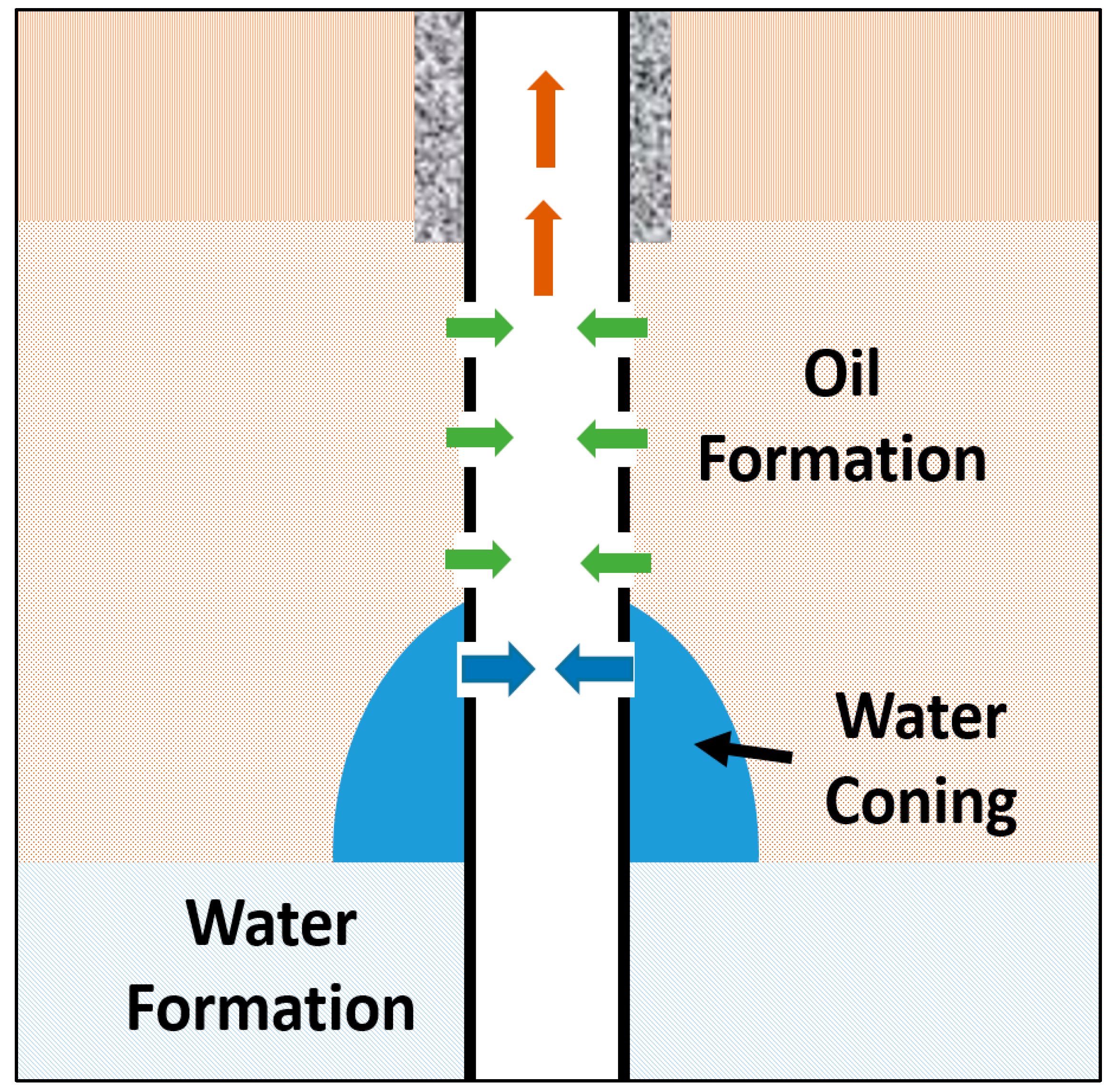
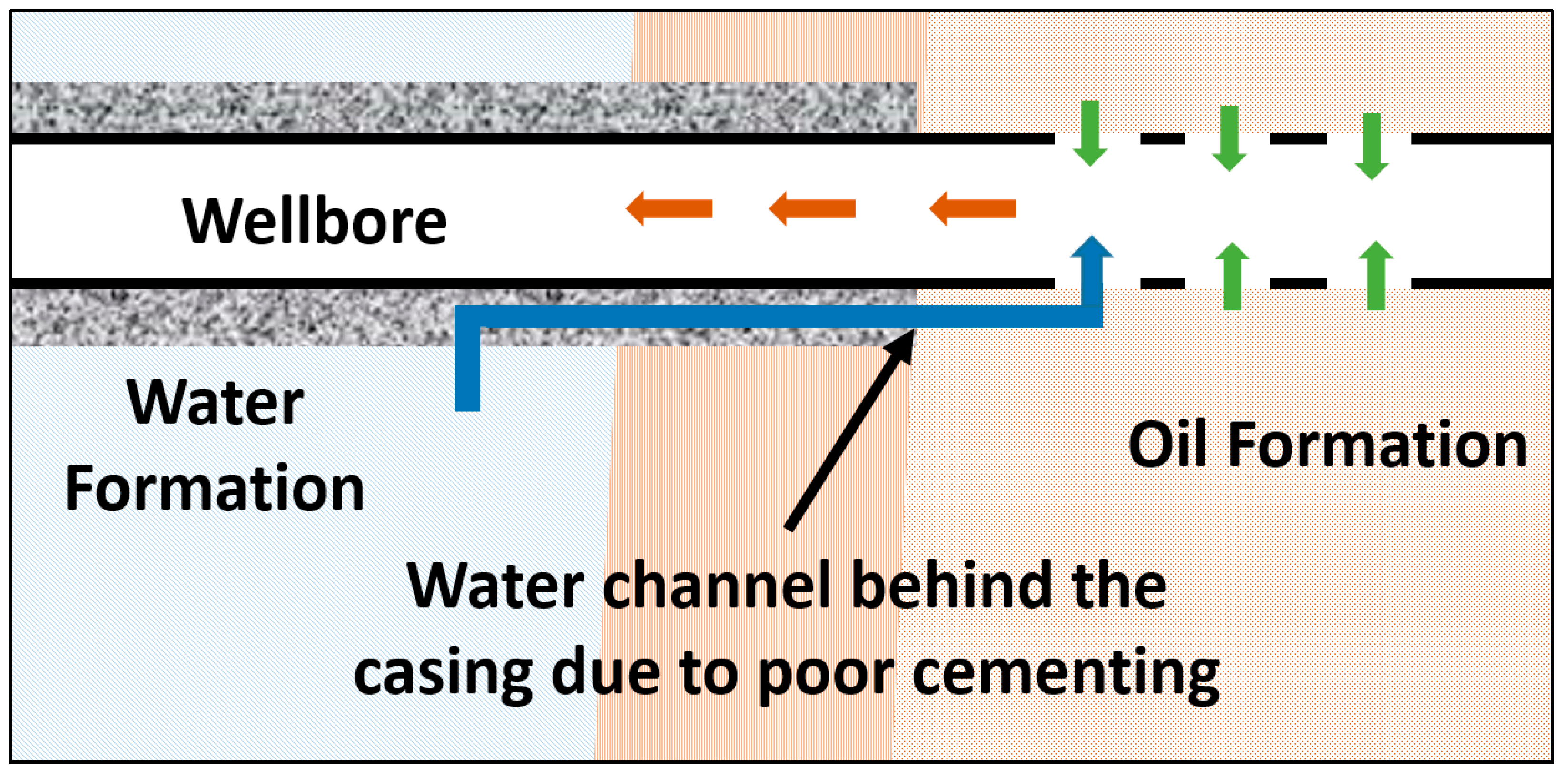
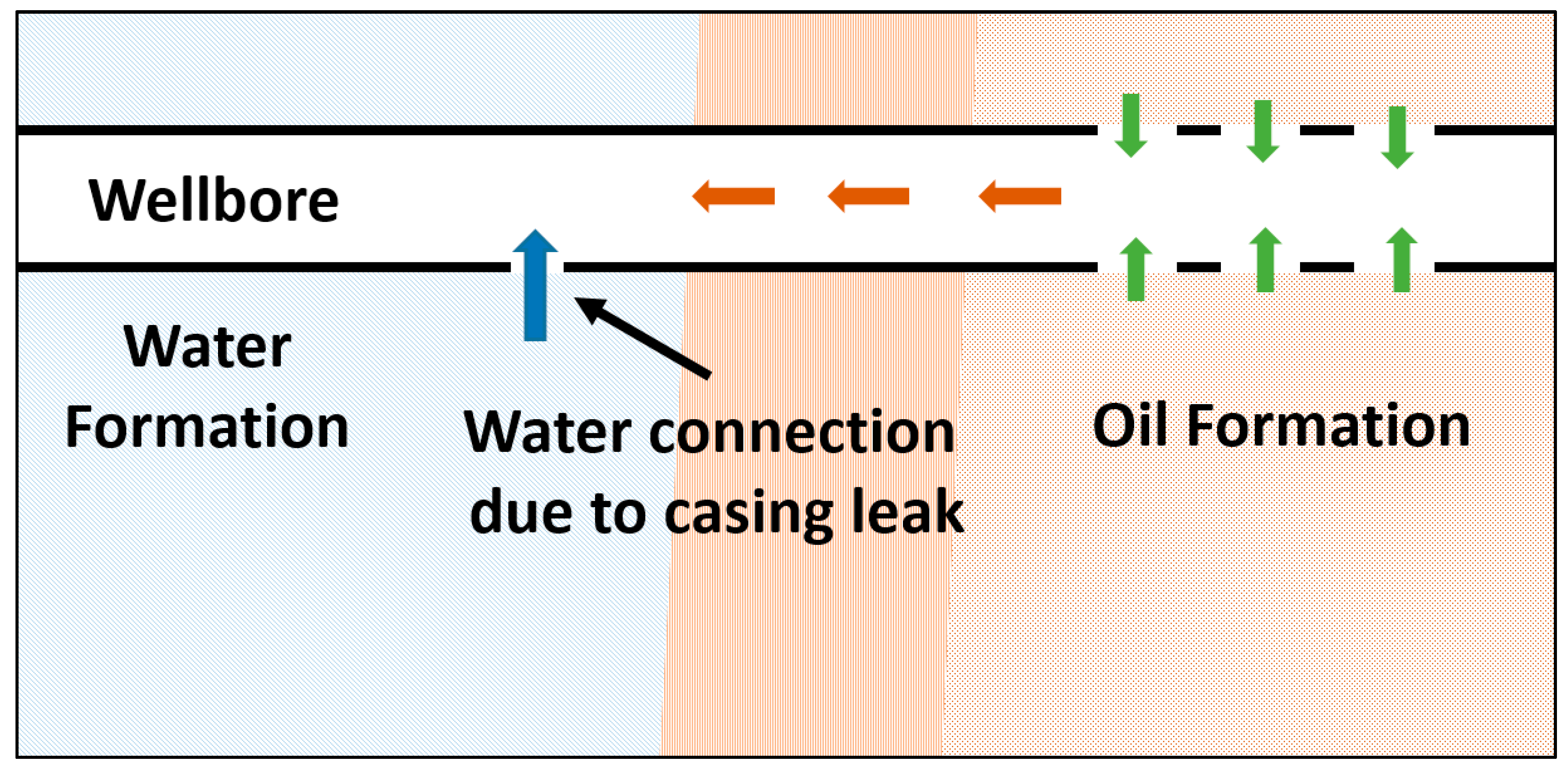
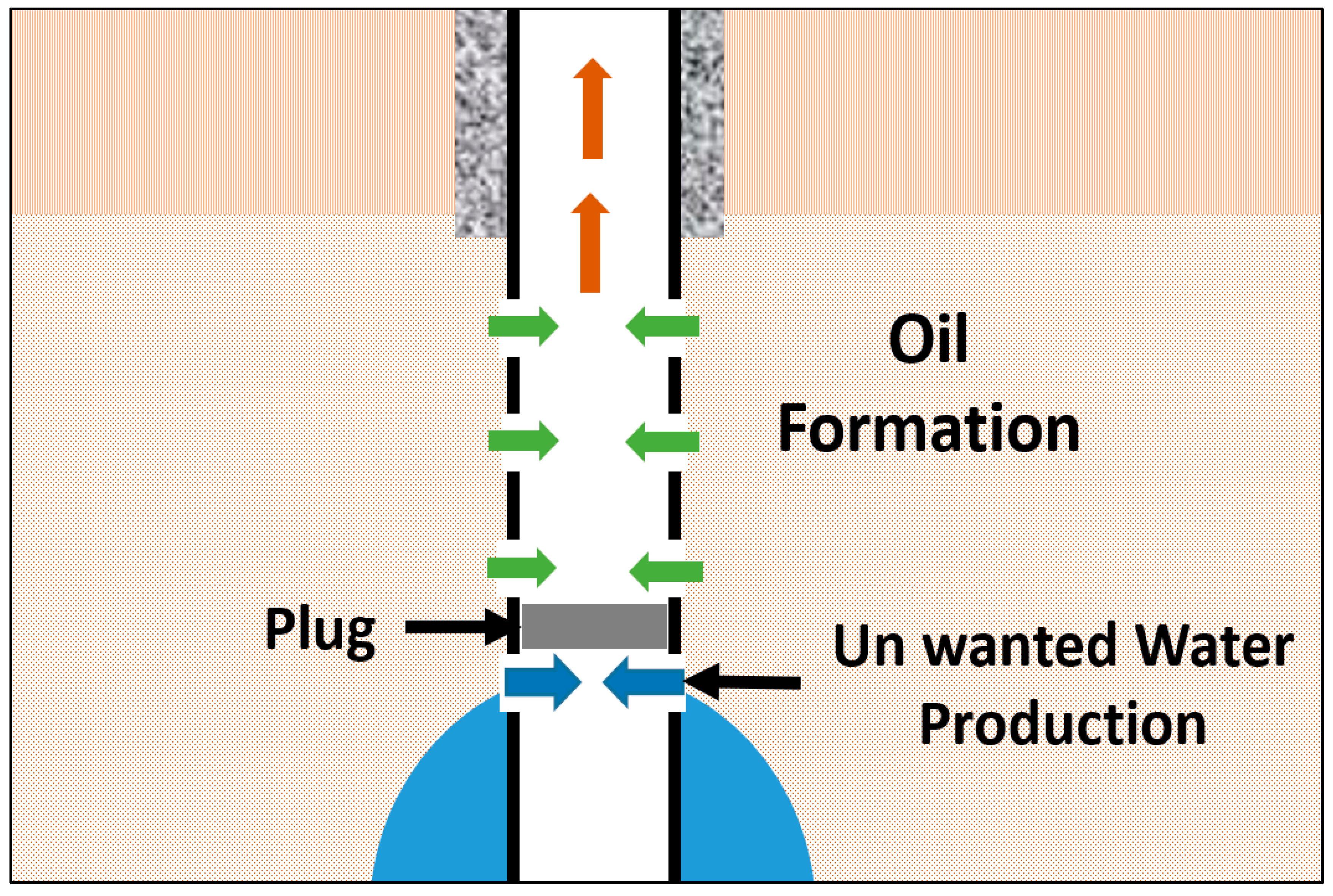
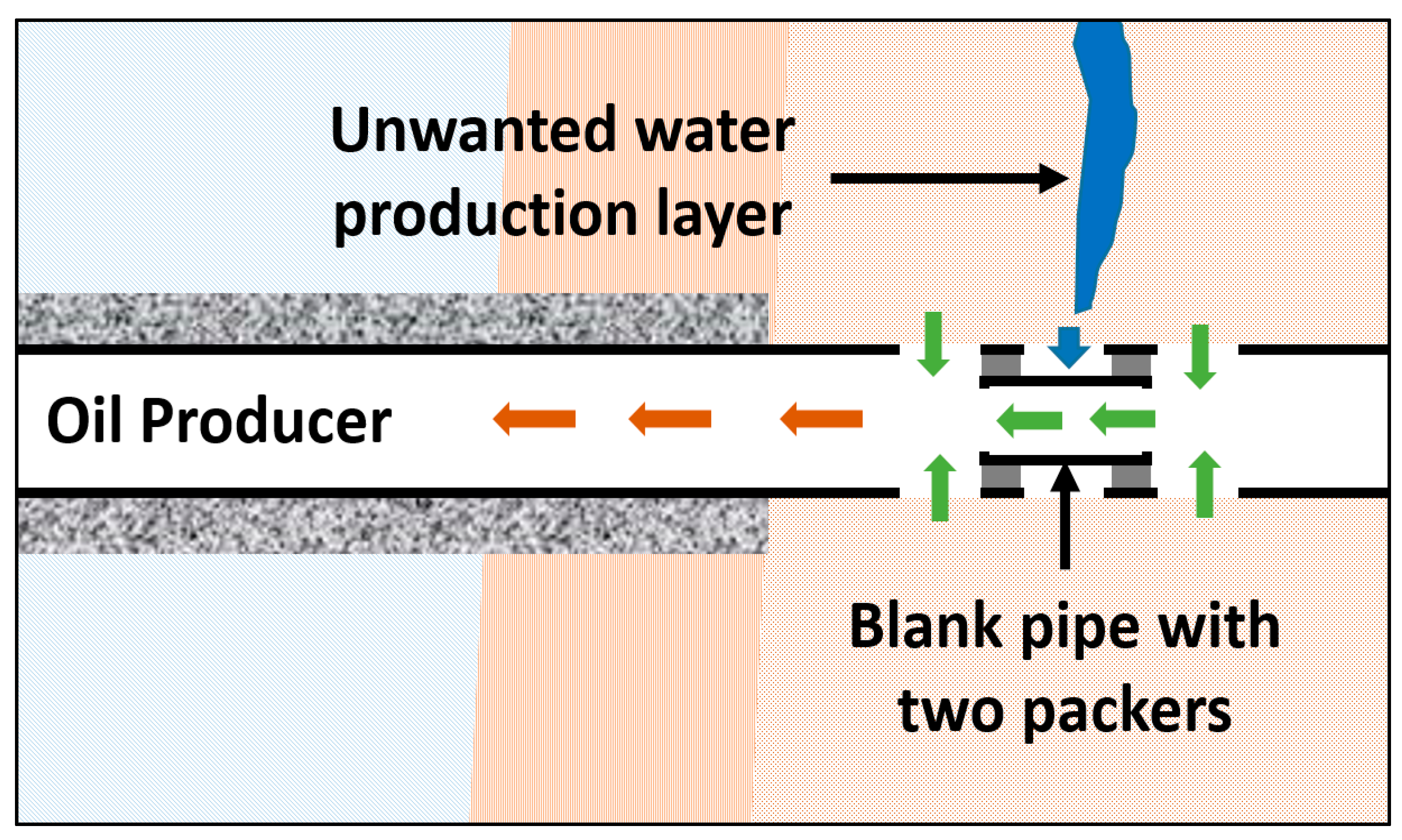
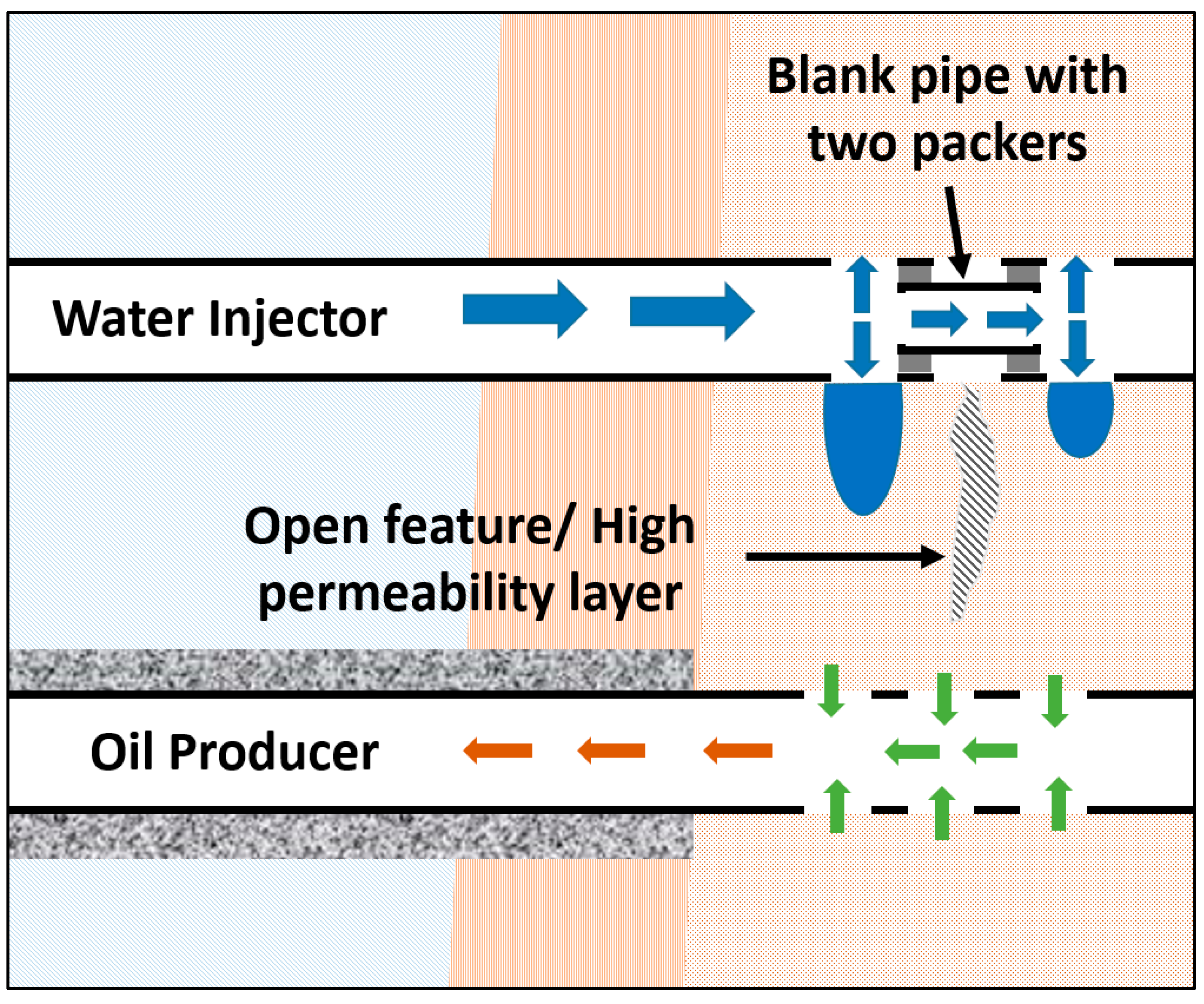
© 2019 by the authors. Licensee MDPI, Basel, Switzerland. This article is an open access article distributed under the terms and conditions of the Creative Commons Attribution (CC BY) license (http://creativecommons.org/licenses/by/4.0/).
Share and Cite
Taha, A.; Amani, M. Overview of Water Shutoff Operations in Oil and Gas Wells; Chemical and Mechanical Solutions. ChemEngineering 2019, 3, 51. https://doi.org/10.3390/chemengineering3020051
Taha A, Amani M. Overview of Water Shutoff Operations in Oil and Gas Wells; Chemical and Mechanical Solutions. ChemEngineering. 2019; 3(2):51. https://doi.org/10.3390/chemengineering3020051
Chicago/Turabian StyleTaha, Abdullah, and Mahmood Amani. 2019. "Overview of Water Shutoff Operations in Oil and Gas Wells; Chemical and Mechanical Solutions" ChemEngineering 3, no. 2: 51. https://doi.org/10.3390/chemengineering3020051




